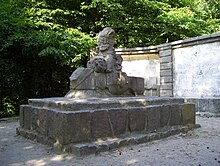Ulanendenkmal (Demmin)
The Ulanendenkmal in Demmin was from 1923 to 1924 on the initiative of veterans of the 2nd Pomeranian Lancers Regiment. 9 in memory of their fallen erected all theaters of war. From 1860 until the unit was disbanded in 1919/20, Demmin was the garrison town of the White Uhlans , a Prussian cavalry regiment . The presence of the regiment and the soldiers' families was one reason for Demmin's increasing prosperity during this period.
The monument was erected on a slope on the western edge of the Sandberg Firs , a forest area in the east of Demmin near the train station . While it is now surrounded by trees, at that time it was clearly visible above the city from afar. It consists of numerous granite boulders , worked to different degrees , which come from megalithic graves in the area. One of the large stone graves near Quitzerow was completely demolished for the construction. Larger blocks were split and partly set up as rune stones . Metal plates with the names of the Uhlans who fell in the wars of 1866 , 1870/71 and 1914 to 1918 were attached to some of them . A staircase made of rough stone blocks leads through an archway entrance, partly flanked by boulders, up the hill. Above, on a brick base, was the bright equestrian statue of a Uhlan with the lance typical of this type of service as the main weapon.
The memorial was financed and commissioned by the Bund vaterlandstreuer 9. Uhlans through donations. The execution was carried out by the Berlin sculptor Fritz Richter-Elsner , who - as was widespread back then - created a monument in the spirit of German nationalism and German cult. The inauguration took place on August 3, 1924, the tenth anniversary of the Uhlans' riding out to the front in the First World War.
At the bottom of the archway entrance there was a heavy rusty iron chain on the threshold. On old postcards it was therefore also referred to as the chain gate to the Ulan monument . The iron chain was intended as a reminder of the situation in the empire as a result of the Treaty of Versailles . After the National Socialists reintroduced general conscription in 1935 - contrary to the provisions of the Versailles Treaty - the chain was broken in a symbolic act and hung on the sides of the entrance as a sign of liberation from the shackles of the treaty.
In 1946 the equestrian monument was destroyed on the instructions of the Red Army and its remains were buried. All stone inscriptions had to be permanently destroyed. The metal plates with the names of the fallen were dismantled and stored. After the reunification of Germany , the fragments of the equestrian statue were dug up again. Some larger parts were put up again as rudimentary sculptures.
literature
- Karsten Behrens: The missing rider. The Uhlan monument in Demmin. Demmin 2016, ISBN 978-3-00-052812-5 .
- Wolfgang Fuhrmann: The Hanseatic City of Demmin in old and new views. GEROS Verlag, Neubrandenburg 1998, pp. 120–121.
Web links
- Literature about Ulanendenkmal (Demmin) in the state bibliography MV
- Demmin: Ulanendenkmal at Orte in MV
- The memorial for the Ulans in Demmin (English)
Coordinates: 53 ° 54 ′ 6.8 ″ N , 13 ° 3 ′ 18 ″ E



